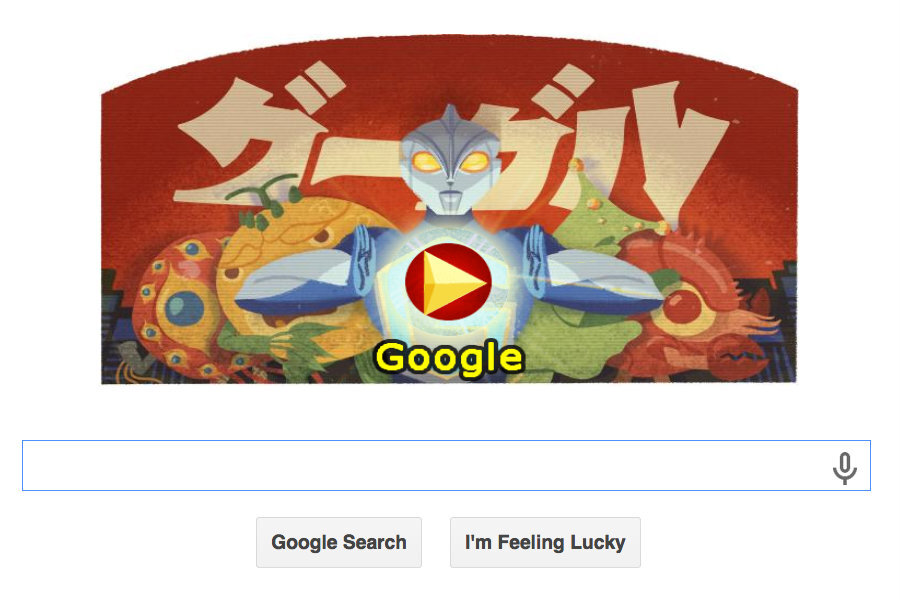What's the deal with Google's Eiji Tsuburaya Godzilla doodle?
Loading...
Eiji Tsuburaya was a monster movie master.
Born 114 years ago on July 7, the Japanese special-effects guru spent his career bringing leviathans to life – think Ultraman, Mothra, and, of course, Godzilla. To celebrate the man’s legacy and the genre of film he helped create, Google has released an interactive Doodle on its home page that gives users a taste of what it’s like to make a movie, Tsuburaya-style.
The Doodle has 10 levels, each of which has the user assisting in one form of filmmaking or another: helping actors put on cumbrous costumes, using giant monster feet to stomp on tanks, or hooking up heroes to wires that make them appear to fly. The mini-movie at the end of the games varies depending on how successful the user is at each task.
The idea is to take users through the process of making a “tokusatsu” movie, the kind of live-action, special effects-laden film that Mr. Tsuburaya revolutionized in his lifetime, Google’s Jennifer Hom said on the company’s Asia Pacific blog.
“Tsuburaya’s legacy was much more than just the monsters he had created,” Ms. Hom, who conceptualized the Doodle tribute, said. “[H]e had pioneered this whole way of making movies that was still being used today.”
Indeed, while Tsuburaya is most remembered for his hand in conceptualizing classic movie monsters – having taken his inspiration from Hollywood’s “King Kong” – it was the techniques he pioneered that make him a film icon in both Japan and the world. His work has involved innovations in lighting, photography, and the building of models for sets.
He also set the standard for suitmation, the process of using an actor in a monster suit to portray a “daikaiju,” or giant monster.
In filming “Godzilla,” released in 1954, Tsuburaya decided to use special effects, miniatures, and costumes in place of stop-motion animation, which was the common technique of the time. The concept was a huge risk.
“Actors were stuffed into a costume that was, at its lightest, 220 pounds,” Vox’s Phil Edwards wrote. “They breathed in kerosene from the fumes of a tiny ‘Tokyo’ model burning beneath them, and actor Haruo Nakajima says he lost 20 pounds in the production because the costume was so physically strenuous.”
It was also the most expensive Japanese movie made up to that time, Mr. Edwards noted.
But the risks paid off. “Godzilla” became a hit worldwide, setting off a craze around the “kaiju,” or monster movie genre. Tsuburaya went on to create the other iconic characters that have made his career unparalleled in the Japanese film industry.
Most popular of these is probably the red and silver giant hero Ultraman, which became a pop culture phenomenon in Japan and is regarded as the inspiration for a number of subsequent films and movies featuring costumed caperers and giant robots.
“It’s fascinating to me how long-lasting the results of his work has been,” Google’s Hom said in another company blog. “It’s easy to see remnants of the tokusatsu style in Guillermo del Toro’s Pacific Rim, Evangelion, and even the Power Rangers.”
Hom’s efforts to create the perfect tribute led her to Tsuburaya’s actual studios in Japan, where she and her team witnessed the production process up close. Costumes and props were made by hand in a secret studio, she said, and there was “a palpable respect for the tradition and legacy that they’re upholding through their craft.”
The resulting Doodle might fall somewhat short for those who had hoped to have a chance at crushing buildings as Godzilla or fighting evil aliens as Ultraman. But it does give a unique look into the magic behind the movies that brought those characters to life.
“While several of ideas revolved around a game format, I thought it would be more interesting and engaging to recreate the filmmaking experience from scratch,” Homs said. “What better way to get an appreciation for the creative challenges Tsuburaya the director had to face?”








